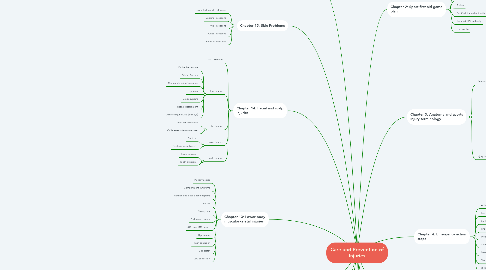
1. Chapter 1: Your role on the athletic care team
1.1. HIPPA guidelines
1.1.1. Set of rules and expectations amongst all healthcare professionals
1.2. FERPA guidelines
1.2.1. Set of rules and expectations amongst all educational professionals
2. Chapter 9: Internal organ injuries
2.1. Thorax injuries
2.1.1. Rib contusion
2.1.2. Flail chest
2.1.3. Pneumothorax
2.1.4. Tension pneumothorax
2.1.5. Hemothorax
2.2. Spleen injuries
2.3. Kidney injuries
2.3.1. Kidney contusion
2.4. Testicular trauma
2.5. Solar plexus
3. Chapter 10: Sudden Illnesses
3.1. Vomiting
3.2. Fainting
3.3. Allergic reactions
4. Chapter 11: Weather related problems
4.1. Cold weather polices
4.2. Hot weather polices
4.3. Lightening policies
4.4. Inclement weather polices
5. Chapter 12: Upper body Musculoskeletal injuries
5.1. Anterior shoulder dislocation
5.2. Rotator cuff impingement
5.3. Colle's fracture
5.4. Clavicle fracture
5.5. Lateral and medial epicondylitis
5.6. AC joint separation
5.7. Biceps tendonitis
5.8. Ulnar collateral ligament sprain
5.9. Scaphoid fracture
6. Chapter 13: Lower body musculoskeletal injuries
6.1. Plantar fasciitis
6.2. Compartment syndrome
6.3. Achilles and patella tendinopathy
6.4. Turf toe
6.5. Shin splints
6.6. Dislocated patella
6.7. ACL and MCL sprain
6.8. Hip pointer
6.9. Thigh contusion
6.10. Side sititch
6.11. Low back strain
7. Chapter 14: Facial and scalp injuries
7.1. Skull Fracture
7.2. Eye injuries
7.2.1. Orbital hematoma
7.2.2. Orbital fracture
7.2.3. Corneal abrasion/laceration
7.2.4. Hyphema
7.2.5. Globe rupture
7.2.6. Retinal detachment
7.2.7. Acute conjunctivitis (pink eye)
7.3. Ear injuries
7.3.1. Auricular hematoma
7.3.2. Otitis externa (swimmers ear)
7.4. Nose injuries
7.4.1. Fracture
7.4.2. Epistaxis (nose bleed)
7.5. Tooth injuries
7.5.1. Tooth fracture
7.5.2. Tooth avulsion
8. Chapter 15: Skin Problems
8.1. Noninfectious skin illnesses
8.2. Bacterial infections
8.3. Viral infections
8.4. Fungal infections
8.5. Parasitic infections
9. Chapter 2: Sport first aid game plan
9.1. Health records
9.2. Emergency action plan in place
9.3. Splints
9.4. Certified first aid authority
9.5. Certified CPR authority
9.6. First aid kit
10. Chapter 3: Anatomy and sports injury terminology
10.1. Anatomy
10.1.1. Humerus
10.1.2. Radius
10.1.3. Phalanges
10.1.4. Ulna
10.1.5. femur
10.1.6. Patella
10.1.7. Tibia
10.1.8. Fibula
10.1.9. Tarsals and metatarsals
10.1.10. Carpals and metacarpals
10.2. Injury terminology
10.2.1. Sprain
10.2.2. Fracture
10.2.3. Stress
10.2.4. Concussion
10.2.5. Strain
10.2.6. Rupture
10.2.7. Shearing
10.2.8. Twisting
10.2.9. Popping
11. Chapter 4: Emergency action steps
11.1. Active shooter
11.2. Bomb threat
11.3. Earthquake
11.4. Fire and fire drills
11.5. Medical emergencies
11.6. Outdoor sirens
11.7. Severe weather
11.8. Shelter in place
11.9. Utility outages
12. Chapter 5: Physical Assessment and first aid techniques
12.1. Questioning
12.1.1. Where does it hurt?
12.1.2. How do you feel?
12.2. Examining
12.2.1. Looking for signs of trauma
12.2.1.1. Cuts
12.2.1.2. Bruising
12.2.1.3. Displaced joint
12.2.1.4. Unresponsiveness
12.2.1.5. Palpation
12.3. First aid care
12.3.1. Preparing a splint
12.3.2. Assisted walk/carry off the field
12.3.3. Seeking medical attention
13. Chapter 6: Moving injured or sick athletes
13.1. Assisting an athlete off the field
13.1.1. Assisted walk off the field
13.1.2. 2 person carry
13.1.3. 4 person carry
13.1.4. Spine boarding athletes
13.2. Crutches
13.2.1. Fitting crutches
13.2.2. Walking with crutches
13.2.3. 4 point gait with crutches
14. Chapter 7: Respiratory emergencies and illnesses
14.1. Asthma
14.2. Anaphylactic shock
14.3. Collapsed Lung
14.4. Hyperventilation
14.5. Solar plexus spasm
14.6. Pneumonia Bronchitis
14.7. Throat contusion
15. Chapter 8: Head, spine, and nerve injuries
15.1. Cervical injuries
15.1.1. Fractures
15.1.2. Acute torticollis
15.1.3. Brachial plexus
15.2. Thoracic spine injuries
15.3. Lumbar spine injuries
15.4. Vascular injuries
15.5. Neuropathies
15.5.1. Ulnar
15.5.2. Carpal
15.5.3. Tarsal tunnel
15.5.4. Peroneal
15.5.5. Diabetic
